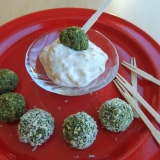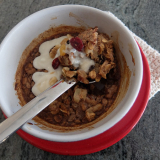This is the first post I have made in an age! I’m converting the contents of this website into a PDF cookbook, and in reviewing the entries, I found I had left out one of the most basic cookie recipes, and the one I use the most. This recipe is older than I am – it’s a classic.
In an effort to take pressure off my feet, I have revised the way I eat. Having discovered that I cannot exist without cookies, I have made a valiant attempt to find a “safe” version, and gingersnaps are my answer. They are extremely easy to make, my recipe doesn’t make a million, and the ratio of ingredients in the recipe allows for a variety of tweaks. One bowl, no rolling and cutting, reliable results. These are the cookies I used to make with my grandsons when they were little, placing the balls to melt into snowmen or teddy bears. I have always been a little surprised how much kids like gingersnaps, as I would consider the flavor quite opinionated, I have made these with little kids and big kids, and no one spits them out.
Here is the basic recipe, and a whole bunch of variations follow.
Gingersnaps
Ingredients
- ¾ cup butter
- 1 cup sugar
- 1 egg
- ¼ cup molasses
- 1 tsp baking soda
- ¼ tsp salt (that’s a three-finger pinch)
- 1 tsp cinnamon
- 1 Tbsp ground ginger (a lot, I know)
- 2 cups flour
Extra sugar for rolling (optional)

Method
Pre-heat the oven to 350°F. Get out a couple of cookie sheets. I bake my cookies one sheet at a time, but you know your oven better than I do. If you can bake multiple sheets at a time, go right ahead.
In a medium microwave-safe bowl, melt the butter. Stir in the sugar. This brings the temperature down so you can add the egg without scrambling it.


Str in the egg and molasses vigorously, to break up the egg.
Stir in the baking soda, salt, cinnamon, and ginger. This ensures the soda and spices are evenly distributed before you add the flour.




Add the flour and stir until there are no pockets of flour hidden anywhere. The dough will be soft. If you let it sit for a couple of minutes while you put parchment paper on your baking sheets, the flour will hydrate and the dough will become easy to handle, but not too stiff to spread as it bakes.


You have a few choices for shaping. Most easy is using a 2 Tbsp portion scoop. You can either place the scoops directly on the cookie sheet, or you can roll them into lovely balls and roll those balls in sugar before placing. The dough spreads while cooking, so leave a few centimeters between the balls. If they tend to roll around, give them a very light squish to keep them in place.


Bake for 14 minutes in the preheated oven. If you bake them less (12 to 13 minutes) they will be chewy; if you bake them more (15 to 15 ½ minutes) they will be crisp. Keep an eye on them – depending on your oven, they may go from crisp to burnt in a very short space of time. Cool on the sheet for a few minutes before removing to a rack to cool completely. Store in an airtight container for a couple of weeks on the counter, or forever in the freezer.

Rolling the dough balls in regular old granulated sugar makes a nice crispy crust and a very pretty cookie. I like to use “Sugar in the Raw”, which has big, pale crystals and great flavor.
When I make these cookies for presents, I make smaller balls and join them with lemon, orange or lime frosting to make sandwich cookies. I put lots of zest in the icing for a strong flavor profile.




And now, the options!
If you don’t want your cookies to spread so much, add a little more flour, maybe ¼ cup to start with. A lot depends on how dry your flour is and how dry your climate is. You can add flour right up to the point where you need to flatten them to get them to bake into cookies rather than golf balls. They start to taste stodgy, though – you may need to up the spice content. The molasses in these cookies is hydroscopic, which means the cookies will draw moisture right out of the air over time, so store them airtight if you want them to stay crisp.
The snowmen or bears. If you don’t freak out and add too much flour to the dough, you can place the balls to make whatever shapes your imagination can come up with, and they’ll melt together like magic. Don’t try to move them until they’re fully cool. If you sugar-coat the dough, all you need to add are eyes and maybe buttons. If you’re having an icing day, leave off the sugar and turn your kids loose. My experience has been that they will add icing until all the icing is gone. I like the combination of ginger and lemon, so you might want to flavor your icing with a little lemon juice, or that dried lemon juice product that’s in the spice section or the juice section in most grocery stores now.






Always eager to experiment, I have a variation on the basic recipe that has been well received. I add a teaspoon of Chinese Five Spice to the dough in addition to the cinnamon and ginger, and I roll the dough balls in sesame seeds. They are almost savory, and a nice change from the ordinary. I have also been known to double the amount of spices in the basic recipe, adding things like chopped candied ginger, orange or lemon zest, even grated fresh ginger. The fresh ginger doesn’t have much impact, but candied ginger does, and I think stem ginger (which comes in syrup in jars) would too. Make sure you roughly chop candied ginger before grinding it in your food processor with the recipe sugar – I wrecked my blade thinking the machine could do the whole job — it doesn’t necessarily. Oops.
Experimentation has shown that these can be made with gluten-free flour, chickpea flour, or peanut flour without the addition of xanthan gum. I haven’t tried making them with oil, but I’ll bet you could. You could certainly use the kind of coconut fat that is solid at room temperature. If you use all brown sugar instead of white, the cookies will be chewier – you could probably leave out the molasses if you made them with dark brown sugar. If you like chocolate and ginger, you can replace up to ¼ cup of flour with cocoa, but the ginger flavor will become quite secondary to the chocolate. Sandwiching the cookies with chocolate icing has been a hit, though (although lime icing was the big winner).
My diet special recipe uses chickpea flour and non-sugar sweetner (usually brown Splenda). I still use the full amount of butter – it is a cookie after all, and all my cookies use butter because to me that tastes best. I add half a cup of Chia seeds, and half a cup of wheat bran. That stiffens the dough to the point where I do need to flatten the cookies in order to get them to bake properly. Not complaining. I call them my “high fibre cookies” (affectionately called “poopers”) and I can have two every day at 4pm with a cup of tea so I don’t eat everything else in the fridge during that hour of maximum vulnerability. I should probably call them “Lifesavers”!


















Leave A Comment